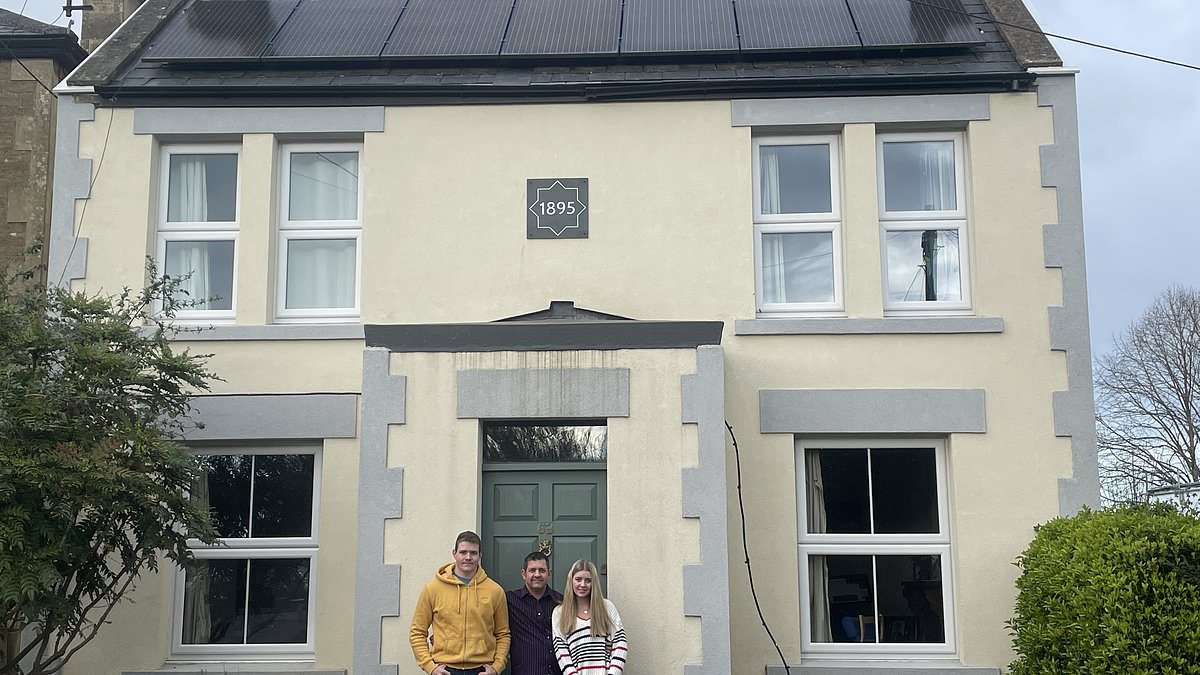A man has been ordered to tear down cladding he put up outside his home after a council ruled it looks ‘highly unsympathetic’.
Tim Stephenson erected the insulated cladding outside his family home in Corsham, Wiltshire, but it failed to meet the conditions of planning permission.
Wiltshire Council points to problems with its ‘vivid’ colour and adds that the extra layer behind the render means ‘walls project further than the eaves of the roof and the coping stones on the verges’.
Mr Stephenson says Wiltshire Council has only given him six months to remove the cladding from his home.
He described the situation as ‘very stressful’ and he had ensured weeks of ‘barely sleeping.’
He said: ‘You don’t wish to be on the wrong side of the law.
Tim Stephenson’s home in Corsham, Wiltshire, pictured (left) before it was fitted with anti-mould cladding, and (right) adorned with the ‘vivid’ rendering which he has been ordered to remove

A plan shows the overall plot of the property (in red), with the rendering at the front of the building (in purple)
‘We had no intention of upsetting our neighbours, the local community, or indeed anybody.’
Mr Stephenson had previously been given council approval for an extension in 2009 as well as new rendering.
It was not until 2022 that he added the rendering, which he fitted with anti-mould insulation.
However he failed to add the horizontal lines that adorned the previous façade of the building – which was a condition of planning permission.
According to the heritage and planning statement: ‘The render that has been finished does not have horizontal lines as previously approved.’
The council ruled that: ‘As a result of the vivid colouring, proportion and detailing, the dwelling stands out in the street scene and significantly harms the heritage assets and their setting by detracting from the dominant vernacular form.’
The cladding was also considered to be ‘highly unsympathetic’ and harmful to the Corsham Conservation Area.
Since then, he claims the council has refused to engage with him after he was issued with an enforcement notice in February 2023.
Mr Stephenson says he has told the council that he is willing to change the colouring and aesthetic of the cladding but that his offer has been ignored.
Mr Stephenson decided to appeal both the refusal and the council’s enforcement notice, but on February 7, the Planning Inspectorate dismissed the appeals and ruled that the cladding should be removed within six months.
Mr Stephenson has started a petition that seeks support from other residents in Wiltshire.
He added that the insulation had solved a mould issue that his family had dealt with for over 20 years.

Tim Stephenson and his children outside their home
He said: ‘We’ve done all of the things that you do, the anti-mould treatment, frequently applied the mould-proof paint.
‘We’d consistently failed to do anything more than keep it under control in the whole time that we’d lived here.’
He added that he was concerned by the impact that the mold returning would have on his children.
He said: ‘My desire would be to say, well, look, we’ve got streets of houses like this that are all cold and damp and that are all emitting tons of carbon and they’re not suitable for heat pumps as a result of their original construction.
‘How are we collectively as a society going to solve this problem?’
Mr Stephenson added he hopes to work together with the council to come to a solution.
He added: ‘The extension was built in accordance with the 2009 permission obtained, but the confusion, doubts and mistake was that the permission did not include insulation on the existing house. So that is the problem. The 2009 permission included render but not insulation on the existing house.
‘What I find interesting is that the Inspector lists ways in which she identifies harm to the heritage, for example the colour of the quoins on my house’s corners that are an unsympathetic colour.
‘This is exactly the kind of mistake I am quite ready to hold my hands up to and work with the Council to deliver both benefits of heritage and sustainability.
‘The professional advice I have received tells me that it would be very common for such changes to be discussed and stipulated within the planning process.
‘However this has not been my experience. Wiltshire simply chose to reject the retrospective application.
‘On one occasion one planner did send a preliminary email suggesting that the colour was an issue, would we change it?
‘We responded with a willingness to consider either the ‘white sand’ approved in 2009 or the previous cement grey. Or anything else frankly. What would be acceptable?
‘The request was swiftly overruled and withdrawn, presumably with a slap on the wrist of the planner involved.
‘Without such discussion it has seemed pointless to submit a further application, which is why I was advised to go instead to appeal.
‘This is the point I would wish get across: Let’s work together to achieve both benefits.’
Councillor Nick Botterill, Cabinet Member for Development Management, said: ‘The issues raised by the owner of the property were all matters considered during the formal appeals process by the Planning Inspectorate who dismissed the appeals and ruled that the property should be restored to its former condition within six months.’



